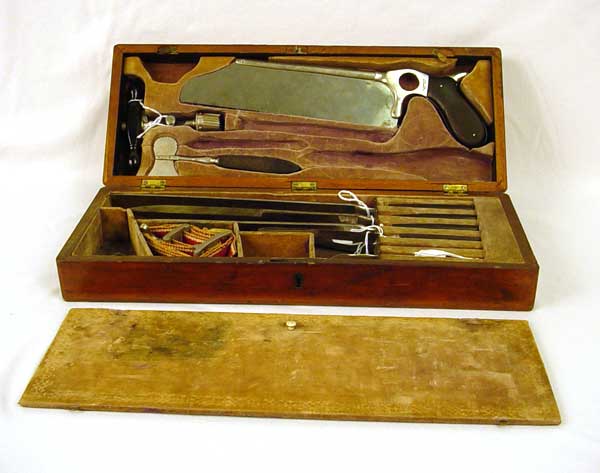In warfare, amputation and infection control have continually been an important area of concern for military doctors and medical officials. Poor sanitary conditions, the presence of foreign bodies in wounds, hasty first-aid treatment, and the large number of wounded, have all contributed to the challenges faced by military medical staff. Faced with mounting casualty rates and complex injuries, doctors on the front lines have had to adapt civilian practices to how they have dealt with the injured. How were these changes in infection theory and amputation reflected in medical instruments and tools? After completing this module students will understand: For each object, answer the following questions: Tiemann Amputation Set Case (About 1865) Doctor's Kit (1890) For each object answer the following questions: George H. Macleod. Notes on the Surgery of the War in the Crimea (Philadelphia: J.B. Lippincott & Co., 1862), 87-93. (PDF 4.2 Mb) Primary Sources Delorme, Edmond. War Surgery. New York: Paul B. Hoeber, 1915. Fauntleroy, A M. Report on the Medico-Military Aspects of the European War. Washington: Government Printing Office, 1915. Hull, Alfred J. Surgery in War. Philadelphia: P. Blakiston's Son & Co., 1916. Penhallow, Dunlap P. Military Surgery. London: Oxford University Publications, 1916. Stevenson, W F. Wounds in War: the Mechanism of Their Production and Their Treatment. New York: Longmans, Green and Co., 1910. Secondary Sources Abstracts of War Surgery: An Abstract of the War Literature of General Surgery That Has Been Published Since the Declaration of War in 1914. St. Louis: C.V. Mosby Company, 1918. Duffy, John. From Humours to Medical Science. Urbana: University of Illinois Press, 1993. Edmonson, James M. Nineteenth Century Surgical Instruments: A Catalogue of the Gustav Weber Collection At the Howard Dittrick Museum of Historical Medicine. Cleveland: Cleveland Health Sciences Library, 1986. Lawrence, Christopher, ed. Medical Theory, Surgical Practice. London: Routledge, 1992. Medicine and Surgery in the Great War 1914-1918. London: The Wellcome Institute of the History of Medicine, 1968. Rutkow, Ira M., and Stanley B. Burns. American Surgery an Illustrated History. Philadelphia: Lippincott-Raven, 1988. Shryock, Richard H. Medicine in America: Historical Essays. Baltimore: The John Hopkins Press, 1966.
Throughout the 19th and 20th centuries, changing perceptions of bacteria and infection control had a profound impact on medical practices and procedures. Such changes were highly reflected in medical tools and instruments, used by doctors, both in the civilian and military fields. While not all of the cases shown in this module were used by doctors on the front lines, the instruments and supplies included in the various surgical cases provide a clear indication of what 19th and 20th century military doctors had at their disposal. As notions of bacteria control and infection prevention became more accepted, military-medical practices as well as their tools and supplies became much attuned to the needs of medical officials. Consequently, with an increased understanding of how to control and limit the spread of infection in wounds, the practice of amputation drastically decreased, as did the overall mortality rates during military campaigns. As illustrated through the medical cases, Improvements in infection control and amputation also affected the composition on surgical instruments, the compounds and chemicals used and the types of surgical dressings and applications. Overall, a noticeable shift towards more sterile practices took place, which was highly reflected in medical-military surgery.Learning Objectives

Step 1: Objects and Their Properties
View Database Entry
Alternative Images
Surgical Set (Late 1910's)
View Database Entry
Alternative Images
View Database Entry
Alternative ImagesStep 2: The Meaning of an Artifact
American Armamentarium Chirurgicum: George Tiemann & Co. 1889 the Centennial Edition (Arlington: Norman & the Printers' Devil, 1989), 61-62, 95-97. (PDF, 2.6 Mb)
Manual for the Royal Army Military Corps (London: Harrison and Sons, St. Martin's Lane, 1904), 32-39, 52-67. (PDF 5.2 Mb)
Selected References for Further Research
You are using a browser that is not standards-compliant. The information on this Web site will be accessible to you, but for a list of Web browsers that comply with the World Wide Web Consortium standards, please visit our Web standards page.

